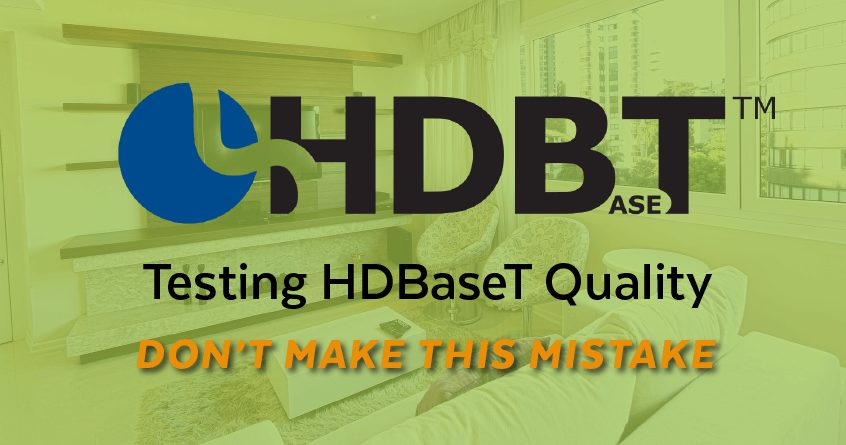Testing HDBaseT quality can be a straightforward process, but if you miss this one step in the process you’ll give yourself a headache later.
Technology is ever-changing, and with consumer electronics, the reality has never been more true: If you’re not keeping up with evolving and changing technology, you will quickly fall behind, costing you time, money and frustration.
Though HDBaseT is the most adaptable technology for home and office audio & video needs, in order to successfully plan, install, and maintain these infrastructures takes ever-evolving knowledge, and the appropriate tools for such adaptations.
There is one quiet killer in particular for HDBaseT quality that, if known about, tested for in your HDBaseT installations, the issue can be avoided or resolved entirely. In order to fully explain this issue and how to discover it, it’s important to understand how HDBaseT technology got to where it is today.
The Power of PoE
In the past, communication between two points required separate circuits entirely: One for communication, and another for power. But with the advent of PoE (Power over Ethernet), this was no longer necessary. This state-of-the-art technology allowed communication planners and technicians an efficient way to provide power for an expanding collection of electronic devices, without the necessity for separate infrastructures. All they needed was the Power over Ethernet infrastructure. Finally, the invention of HDBaseT took high-tech communication to new levels of quality and speed, and expanded diversity of the infrastructure.

With this, PoE became PoH (Power over HDBaseT), meaning all of the conductors in the cable infrastructure not only carried communication, but the DC current as well to a multitude of different components. The outcome? – any issues with the DC power in the HDBaseT networks now negatively impacted the quality and dependability of transmissions.

Because of this latest update in technology, one thing is clear: Testing HDBaseT infrastructure is imperative – whether you’re solving issues, expanding your current infrastructure, or installing new infrastructures.
It is, of course, attractive, to make what you have as efficient as possible, to take on the largest load possible. However, if you’re not testing for DC-related problems, you could be setting yourself up for disaster. Conversely, getting rid of the infrastructures you already have for unknown concerns doesn’t entirely make sense either. And moreover, even new cables should be checked for their ability to handle PoH and high-quality transmissions concurrently, since the materials of any one cable may differ from another, and therefore affect the network quality.
HDBaseT Quality Testing
So what is it that you need to test in order to determine the health and quality of your current HDBaseT? Think about current. With any DC, resistance is going to be the biggest enemy. And the higher the DC resistance, the bigger the issue.
Therefore, what you may think to do is to test the DC resistance of individual wires & wire pairs. While this is important, you’ll want to do more than just that. In order to appropriately determine the health of the Power over HDBaseT capacity, you will need to test the entire cable as a whole. See, each individual wire might be performing healthily, but the entire cable as a whole could not be due to differences in the DC resistance of each twisted pair, or the DC resistance unbalance.
That means 3 DC resistance values are needed to understand the overall picture of the HDBaseT infrastructure’s health: the resistance of individual wires, total resistance and resistance unbalance within pairs, and DC resistance unbalance between all pairs. That way, you’ll get the true answer about the ability of your HDBaseT infrastructure to hand PoH while maintaining its highest quality transmission that it possibly can.
Conclusion
Now here’s the good news: there are plenty of options out there on the market to test DC resistance and DC resistance unbalance effectively and reliably. Prices and capabilities of the various models will vary widely, but few will offer full testing capabilities while supporting all necessary DC resistance functions.
Understanding is a key element to success. You can’t fix an issue if you don’t know what to look for. That’s why being aware of the potential problems that DC resistance can cause in your HDBaseT network, as well as knowing how to check these parameters with the appropriate tools is so important to prevent network disruptions before they arise.

